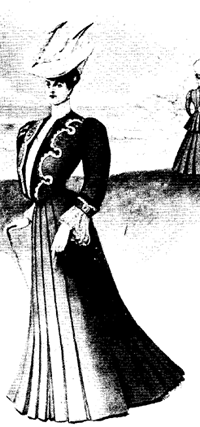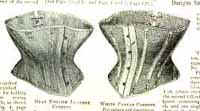Federation fashions
| Federation 1901 - 1914 Australia became a Federation in 1901, the year King Edward VII ascended the English throne. In France, this era was known as La Belle Epoque and in England and Australia as the Edwardian Era. These were optimistic times in Australia and across the world. During this exciting period the cinema was developed, the first horseless carriage which roared up and down the roads at 25 mph, and the first Australian passenger liner was launched. Fashion was reflected in all these aspects of life - in architecture, art, literature, gardens and in clothing.
| |
| The fashions Fashion trends were set in France and England, and in Australia women copied these styles even though they were not necessarily suited to the Australian climate or lifestyle. | ||
| Cascades of lace. In favour for women was the "mature" woman look with heavy forward thrust bust achieved by the tightly laced S-bend corset which pressed firmly on the abdomen throwing back the hips. Sleeves were very long and tight. Bodices were pouched in front and excessively overloaded with frills flounces, tucks, insertions, accordion pleats, elaborate embroidery, and cascades of lace. Irish crochet was a good substitute for authentic lace. Collars were high and boned. | |
| Feather boas Skirts fitted smoothly over well rounded hips then flared to the floor in the shape of a bell, and with a train. Boleros, stoles, feather boas, a wide variety of jackets, fans, parasols and gloves were popular. Hair was dressed in a soft full style and hats assumed large dimensions, projecting forward as if to balance the train. Ostrich feathers, large flowers, clusters of ribbons and bows were stylish. Ladies were covered from chin to toes. Shoes had high heels, pointed toes and were laced and buttoned. Stockings were black. Evening gowns of lightweight fabric in delicate pastel colours were sumptuously trimmed. | ||
| Tailor made garments Tailor made garments were more practical and were available through mail order catalogues. They were worn by a younger woman who earned her living working as a typist, shop assistant, governess or by the rich woman who favoured them for travel and country wear. The loose tea gown was popular for informal home dress.
| ||
| Kimono style About 1908 slimness became fashionable and garments were straightened and more slender with a narrower hemline, a high waist and draperies about the hips. The harem skirt and the tight hobble shirt were in vogue at this time. The oriental influence was seen in 1910 in kimono style clothing and turbans. Colours were bold and prints dramatic. The favourite trims were buttons, cord and applied braid. The lampshade tunic made its appearance worn over a tight skirt or daring loose harem trousers. | ||


